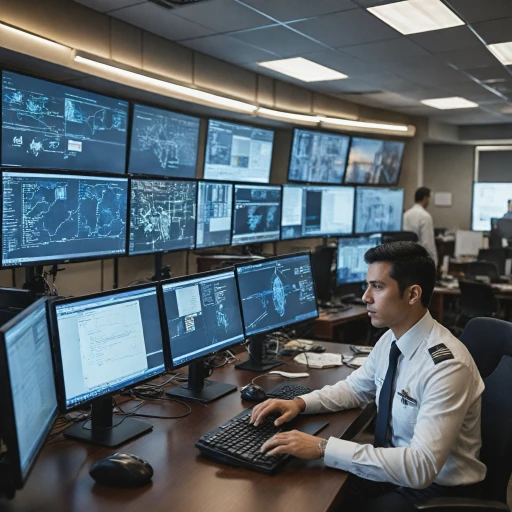Understanding the Chief Executive Officer's Role
Leading the Vision and Direction
In the intricate tapestry of modern business, the Chief Executive Officer (CEO) stands as the linchpin of vision and direction. This pivotal role requires a delicate balance of strategic foresight, operational oversight, and inspirational leadership. As the face of the company, the CEO is tasked with steering the organization towards its long-term goals while navigating the complexities of the business landscape.
The CEO's responsibilities extend beyond mere management; they encompass the articulation of a clear vision that aligns with the company's values and mission. This vision must be communicated effectively across all levels of the organization, fostering a culture of unity and purpose. In doing so, the CEO sets the tone for the company's strategic priorities and operational focus.
Moreover, the CEO collaborates closely with other top-level executives, such as the Chief Financial Officer (CFO) and Chief Operating Officer (COO), to ensure that financial strategies and operational efficiencies are aligned with the overarching corporate objectives. This collaboration is essential in maintaining a cohesive approach to business growth and sustainability.
For those interested in delving deeper into how effective leadership can be mastered within this role, mastering effective leadership in business offers valuable insights.
As we explore the strategic impact of other key roles within the C-suite, such as the CFO's financial acumen and the COO's operational expertise, it becomes evident that the CEO's role is integral to orchestrating these diverse functions into a harmonious and successful enterprise.
The Strategic Impact of the Chief Financial Officer
Exploring the Strategic Role of Financial Leadership
In the dynamic environment of today's business world, the role of the Chief Financial Officer (CFO) extends far beyond the conventional tasks of managing company finances. While it's crucial to ensure financial stability and compliance, the modern CFO is increasingly becoming a pivotal player in shaping organizational strategy. As businesses grow more intricate, the CFO's influence touches nearly every facet of the company. This top-tier executive position demands not only an acute financial acumen but also strategic foresight. It's about understanding, anticipating, and mitigating potential financial risks while fostering an environment that empowers innovation and efficiency. Financial leadership, therefore, involves not just budgeting and forecasting but also providing valuable insights that can transform business trajectories. Collaborating closely with their CEO and other C-suite executives, CFOs contribute significantly to strategic decision-making, ensuring that the organization aligns its financial resources with its long-term objectives. If you are intrigued by how financial leadership can be harnessed to steer company strategy towards success, consider delving deeper into the topic through resources that focus on mastering effective business strategy and leadership, such as this insightful guide on effective business strategy and leadership. Moreover, in a world where change is constant, CFOs are often at the forefront of adopting and integrating new technologies that streamline processes and enhance decision-making capabilities. Therefore, embracing digital transformation is no longer optional for CFOs but rather a cornerstone of their strategic toolkit. The evolving landscape necessitates that CFOs maintain a delicate balance between being grounded in financial principles and being open to innovative pathways. This dual capacity enables them to lead their organizations with a visionary approach, integrating financial management with overarching business strategies.The Importance of the Chief Operating Officer
Maximizing Operational Efficiency
In the dynamic world of modern business, the role of the Chief Operating Officer (COO) is pivotal in translating strategic vision into operational reality. While the CEO sets the overarching direction and the CFO ensures financial viability, the COO is the linchpin that ensures the seamless execution of these strategies.
The COO is responsible for the day-to-day operations of the company, which involves a complex interplay of managing resources, optimizing processes, and ensuring that the company's goals are met efficiently. This requires a deep understanding of the company's internal workings and the ability to adapt to changing market conditions swiftly.
One of the key challenges for COOs is to maintain a balance between innovation and operational stability. As highlighted in discussions about the Chief Technology Officer's role, driving innovation is crucial, but it must be harmonized with the company's operational capabilities. The COO ensures that new initiatives are not only groundbreaking but also feasible and sustainable in the long term.
Moreover, the COO plays a crucial role in aligning the workforce with the company's strategic objectives. This involves close collaboration with the Chief Human Resources Officer to foster a culture of continuous improvement and agility. By doing so, the COO helps in building a resilient organization that can withstand the pressures of a competitive market.
For professionals aspiring to step into the COO role, it's essential to focus on building a diverse skill set that encompasses both strategic and operational expertise. Understanding the nuances of how to boost your resume can be a significant step in standing out in your job search and advancing your career in this challenging yet rewarding field.
Driving Innovation with the Chief Technology Officer
Fostering Technological Innovation in Business
In the ever-evolving landscape of business, the role of the Chief Technology Officer (CTO) has emerged as a critical driver of innovation within an organization. While the Chief Executive Officer provides the overarching vision and the Chief Financial Officer ensures resources are allocated efficiently, it is the CTO who is often at the helm of technological advancement. The modern CTO must not only possess deep technical expertise but also a persuasive vision that aligns technology with business goals. This role requires a unique blend of technical acumen and strategic foresight, empowering companies to navigate the complexities of digital transformation.Aligning Technology with Business Objectives
To drive innovation successfully, the CTO must work closely with other key executives, such as the Chief Operating Officer, who ensures that the company’s operational strategies are implemented smoothly. The synergy between operations and technology is crucial, as operational efficiency often depends on cutting-edge technological solutions. Furthermore, the CTO needs to collaborate with the Chief Marketing Officer to ensure that technological advancements are aligned with the brand's growth strategies. This collaboration can result in seamless customer experiences, boosting the brand’s reputation and market position. Ultimately, the CTO's challenge is to anticipate tomorrow's technological trends and find ways to incorporate them into the company’s strategic framework today. This proactive approach not only positions the company as a leader in innovation but also creates a competitive edge in the marketplace.The Path Forward
As businesses continue to rely more heavily on technology for their operations, the integration of evolving tech trends becomes non-negotiable. Building partnerships with innovative startups, investing in research and development, and fostering a culture of continuous learning within the tech team are some of the strategies that the CTO can employ to stay at the forefront of innovation. Under the CTO’s guidance, companies can leverage technology not just as a tool for efficiency but as a catalyst for creating new business opportunities. In doing so, they ensure their sustainability and relevance in rapidly changing industries.The Role of the Chief Marketing Officer in Brand Building
Building a Compelling Brand Image
In the dynamic landscape of modern companies, the responsibility of crafting and maintaining a brand's image largely rests with the Chief Marketing Officer (CMO). As an essential member of the executive team, the CMO drives the strategies that define how a brand is perceived both internally and externally. Their role is not just about advertising or promotions; it involves shaping the very essence of a company’s identity.
A CMO's influence extends across various sectors of a company, from product development to customer relations. This interconnected role ensures that messaging, both strategic and tactical, is consistent and reinforces the core values of the brand. In this way, CMOs work hand-in-hand with the CEO and the rest of the C-suite to align the brand's image with the overarching company strategy, thereby supporting the business's long-term goals.
Leveraging Data and Analytics
One of the defining features of a successful CMO in today's market is their ability to use data-driven insights to guide marketing strategies. By analyzing customer behavior, market trends, and competitive landscapes, CMOs can craft marketing campaigns that not only attract new customers but also foster loyalty among existing ones. This reliance on data ensures that marketing initiatives are not just creative but also incredibly efficient and targeted.
A Collaborative Approach
The CMO doesn’t operate in a silo; collaboration is key. By working closely with the Chief Technology Officer (CTO), CMOs can harness the latest technology to drive innovation in their marketing efforts. Whether it's leveraging AI for personalized marketing or utilizing new digital platforms, the partnership between marketing and technology can lead to groundbreaking methods of engagement.
Furthermore, integration with the Chief Human Resources Officer (CHRO) is crucial as well. By collaborating on employer branding, CMOs help attract top talent, enhancing the company’s brand from the inside out. Such initiatives highlight how crucial the CMO's role is in developing an attractive brand image that resonates with both employees and customers.














